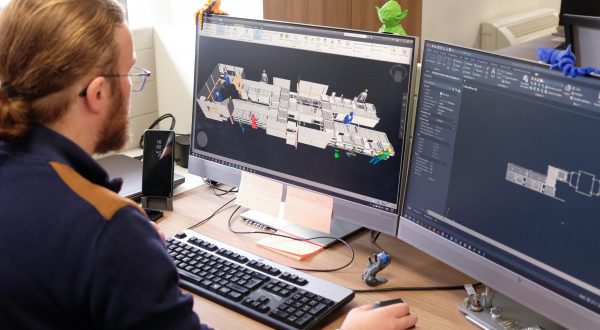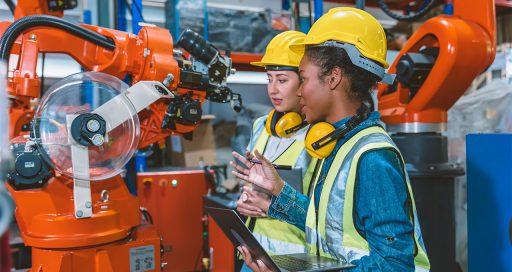In a report on Industry 4.0 in France, the Institut Montaigne think tank concludes that there is a need to set up 20 accelerator centres in the country. Vincent Bouffard, deputy managing director of VINCI Energies France, breaks the report down.
![]()
Industry 4.0 isn’t simply another buzzword like cobot, artificial intelligence, blockchain, augmented reality, or predictive maintenance. It’s the start of a genuine revolution in the industrial model, and the potential it offers could “help France revive its industrial tradition.” This is the conclusion reached in the “Industrie du futur, prêts, partez !” (Industry 4.0, get set, go!) report published in September 2018 by Institut Montaigne in partnership with Boston Consulting Group (BCG).
But in order for the Industry 4.0 revolution to grow and deliver on the promises of new technologies, “roll-out must be urgently accelerated,” state the authors of the report. Their assessment of the current situation is a mixed one, leading them to recommend the creation of 20 accelerator centres in France.
France has assets and is not starting from scratch. The professional training reform is a step in the right direction, as are the discussions on company taxation, the report on artificial intelligence, the support given to 3D printing, and the reshaping of the role of sectors with France Industrie (the trade organisation representing industry in France). Support schemes, such as competitiveness clusters, do exist but they are “fragmented” and their effectiveness is called into question.
Investment from SMEs (small and medium-sized enterprises) and intermediate-sized enterprises is flagged as a negative point. Just 13 % of them make digital transformation a strategic priority, according to a survey carried out by French investment bank Bpifrance in September 2017. But the industrial revolution cannot be achieved by major groups alone, which do have the required tools, says the report.
Involving SMEs is a priority
Vincent Bouffard, deputy managing director of VINCI Energies France (800 business units in France), confirms the assessment and believes it’s crucially important to find ways to involve SMEs in the industrial revolution.
However, he says, “heads of industrial companies are busy taking care of acute operational and recruitment problems, and many have not incorporated digital transformation into their priority investments. So, it’s not clear whether the creation of 20 accelerator centres, as promoted by Institut Montaigne, will be enough to convince them to come out of their factories and embrace Industry 4.0.”
According to the report, these centres will need to provide a comprehensive offering built around innovation, training and support.
So how will this initiative succeed where existing systems have partially failed? How can SMEs be linked to an ecosystem of major groups, technology suppliers, startups, training centres, consultancies, and funding bodies?
Focusing on a sectoral approach
“Taking a sectoral approach” will help achieve this, says Vincent Bouffard, who thinks that greater accelerator centre density is needed to ensure local needs are met, with each one promoting sector-based solutions. “An SME operating in the food processing sector will be attracted by a blockchain-driven traceability solution, but perhaps less so by a 3D printing demonstration,” he states as an example.
“Start on the basis of performance improvement objectives rather than technology implementation”
One of the key ways of getting company heads on board, adds the deputy managing director of VINCI Energies France, is to “focus on uses, not technology,” by explaining what purpose a solution serves rather than describing its operating principle.
“It’s by presenting operational innovations that can be immediately incorporated into the factory that we’ll get SMEs interested,” points out Bouffard who fully supports the guidance outlined in the BCG report: “to start on the basis of performance improvement objectives rather than technology implementation.” Indeed, technologies alone account for just 10 % of the impact; the much greater share comes from the way in which employees use them.
Factory Lab example
The Institut Montaigne report also highlights the fact that “80 % of the potential linked to new technologies can already be achieved in current factories by incorporating them into existing facilities and information systems.” Vincent Bouffard agrees, referring to an example of operational innovation developed by the Saclay-based Factory Lab, of which VINCI Energies is a founding member. A steel construction factory needed a solution for transporting heavy parts within its warehouses. However, the configuration of the site meant that it wasn’t possible to use the ultimate “4.0 solution”, the AGV, an automatic guided vehicle which travels along the floor without human intervention.
The Factory Lab therefore developed a device where an operator is followed by a narrow trolley equipped with a jointed arm, a solution suitable for negotiating curves in warehouses that don’t accommodate AGVs. “We didn’t want to tear the warehouses down only to rebuild them! It was about adapting a technological innovation,” says Bouffard. While this may not be a pivotal moment for Industry 4.0, it does illustrate continuous improvement of processes and performances.





